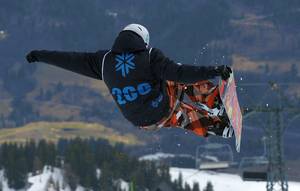The Winter Olympics are finishing in Sochi, Russia this week. But it's not just the  athletes who've spent the last four years training for the event. Engineers and designers have also been working to reduce times and grab golds on the slopes. In fact, when asked about her gold medal in the Women's Snowboard Cross Eva Samkova from the Czech Republic said "It's just physics, that's all,". To find out more, here's your Quick Fire Science with Kate Lamble and Harriet Johnson.
athletes who've spent the last four years training for the event. Engineers and designers have also been working to reduce times and grab golds on the slopes. In fact, when asked about her gold medal in the Women's Snowboard Cross Eva Samkova from the Czech Republic said "It's just physics, that's all,". To find out more, here's your Quick Fire Science with Kate Lamble and Harriet Johnson.
· - Friction, air resistance, and gravity are the main forces that track and equipment designers working on the Winter Olympics need to consider when they are trying to make times as quick as possible.
· - In order to reduce friction, skis and snowboards are waxed before use. A professional wax technician has around 500 different products to choose from and selects the right wax for the snow conditions.
· - When the snow is wet, a water repellent additive called fluoro, is increased in the wax, but this can create more friction if too much is added. Antistatic waxes can also be used to reduce electrostatic charges which can build up over long races.
· - Snow type has been a problem for some races in Sochi with snowboarders complaining of soft snow in the halfpipe. By spraying water and salt onto tracks organisers hoped to melt this soft top layer before allowing it to freeze again into harder ice.
· - Rather than snow, ski jumping tracks are actually made from ceramic. When moistened with water, these have the same friction characteristics as snow but allow the sport to be conducted all year round in almost identical conditions.
· - To combat air resistance special skin tight suits are worn in a number of sports. However Team USA have just dropped their newly designed speed skating outfits following poor performances.
· - There have been some suggestions that vents on the backs of the suits, designed to dump excess air might instead be causing a slight drag effect. While this hasn't been proven the team chose to swap the suits as athletes were concerned about the possibility of their performance being affected.
· - In other sports, equipment is also important to help athletes perform at their best. In luge, weight vests can be worn by lighter competitors to minimise the advantage carried by their heavier peers.
· - In curling, players wear one rubber soled shoe to allow them to push off from the ice and one teflon soled shoe. The teflon has a reduced friction coefficient and so allows them to glide across the ice.
· - Commercial companies also help in designing equipment. Great Britain's gold medallist in the women's skeleton had her sled designed by motorsport company McLaren. The designers used computer simulation to make sure it could be adapted to suit a range of different tracks.
- Previous Stress depresses markets
- Next Modelling the brain









Comments
Add a comment